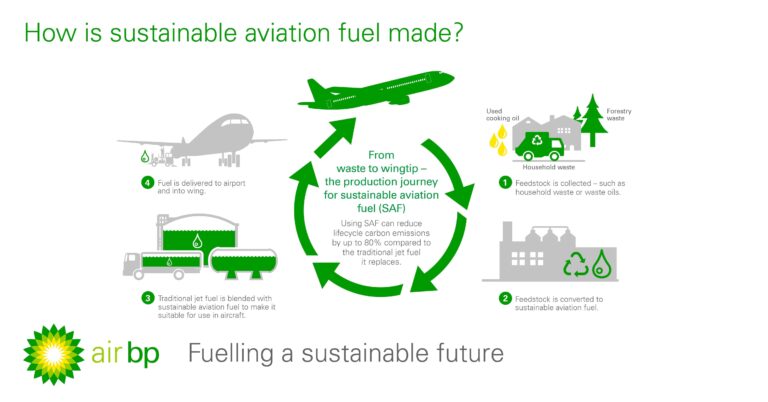Air bp’s Sustainable Aviation Fuel Takes Off at France’s Clermont Ferrand Airport
In a significant stride towards greener aviation, Air bp has launched its Sustainable Aviation Fuel (SAF) at Clermont Ferrand Airport in France. This milestone is part of a broader initiative to reduce the carbon footprint of air travel, aligning with global efforts to combat climate change. The introduction of SAF at this regional airport not only underscores Air bp’s commitment to sustainable practices but also sets a precedent for airports across Europe to adopt cleaner fuel alternatives. As the aviation industry faces increasing pressure to adopt environmentally responsible practices, the successful deployment of SAF at Clermont Ferrand represents a pivotal moment in the journey towards a more sustainable future in air travel.
Air bp Launches Sustainable Aviation Fuel Initiative in Clermont Ferrand
Air bp has made a significant leap toward ecological sustainability with its latest initiative at Clermont Ferrand Airport, launching a supply of Sustainable Aviation Fuel (SAF). This innovative fuel, derived from renewable sources, aims to reduce carbon emissions by up to 80% compared to traditional jet fuels. As the aviation industry seeks to mitigate its environmental impact, Air bp’s move underscores the company’s commitment to facilitating a greener future for air travel.
The introduction of SAF at Clermont Ferrand comes amid growing demand for responsible aviation practices. Stakeholders in the aviation sector recognize the importance of transitioning to cleaner fuel alternatives. The initiative will not only support local airlines and operators but also align with France’s broader commitment to achieving carbon neutrality. Key benefits of using SAF include:
- Carbon Reduction: Lower lifecycle emissions.
- Compatibility: Can be used in existing aircraft engines without modification.
- Local Investment: Supports regional economies through sustainable practices.
| Fuel Type | Emissions Reduction | Source |
|---|---|---|
| Traditional Jet Fuel | 0% | Fossil Fuels |
| Sustainable Aviation Fuel | Up to 80% | Renewable Sources |
Impact of Sustainable Aviation Fuel on Carbon Emissions in Aviation
The introduction of sustainable aviation fuel (SAF) at Clermont Ferrand Airport marks a significant milestone in the aviation industryŌĆÖs efforts to reduce carbon emissions. This innovative fuel is engineered to be a drop-in replacement for conventional jet fuel, which means it can be utilized in existing aircraft and infrastructure without requiring major modifications. By using SAF, airlines can potentially reduce their lifecycle carbon emissions by up to 80% compared to traditional fuels. This has critical implications for achieving emissions reduction targets mandated by international frameworks, driving a shift towards greener air travel.
Moreover, the adoption of SAF not only paves the way for a more sustainable aviation industry but also supports the local economy by fostering developments in the sustainable energy sector. The benefits of SAF extend beyond carbon reduction to include the following points:
- Boosting local production: The use of locally sourced feedstocks for SAF can spur economic growth and job creation.
- Enhancing energy security: Reducing dependency on fossil fuels decreases vulnerability to price fluctuations.
- Encouraging innovation: Investments in SAF technology can lead to advancements in biofuel production and related fields.
As aviation stakeholders increasingly embrace SAF, the potential for large-scale implementation emphasizes its role as a transformative solution for the future of aviation. AIR bp’s initiatives at Clermont Ferrand Airport exemplify how collaboration between industries can ignite a systemic shift towards environmentally responsible air travel.
Benefits and Challenges of Adopting Sustainable Aviation Fuel at Regional Airports
The adoption of Sustainable Aviation Fuel (SAF) at regional airports like Clermont Ferrand offers numerous benefits that align with global environmental goals. With reduced lifecycle greenhouse gas emissions compared to traditional jet fuels, SAF not only contributes to lower carbon footprints but also enhances the sustainability profile of the airport. Key advantages include:
- Lower Emissions: Provides a cleaner alternative that significantly reduces CO2 output.
- Enhanced Reputation: Positions the airport as a leader in sustainable practices, attracting eco-conscious travelers.
- Regulatory Compliance: Helps meet future sustainability regulations sooner, ensuring longevity and viability.
However, shifting to SAF is not without its challenges. Regional airports often face hurdles related to infrastructure and supply chain logistics. Some of the primary obstacles include:
- Cost: SAF can be more expensive to produce than conventional aviation fuel, impacting operational budgets.
- Limited Supply: Availability of SAF is still limited, which may pose procurement challenges for small airports.
- Infrastructure Requirements: Existing fueling systems may need upgrades to handle SAF’s specific needs.
Future Steps for Expanding Sustainable Aviation Practices in France
The launch of Air bp’s Sustainable Aviation Fuel (SAF) at Clermont Ferrand Airport marks a significant step towards enhancing eco-friendly aviation in France. As the aviation sector grapples with its environmental impact, the emphasis on SAF can transform air travel into a more sustainable mode of transport. Key areas of focus for expanding sustainable aviation practices include:
- Infrastructure Development: Investments are needed in biofuel production facilities to ensure a steady supply of SAF, coupled with the necessary airport infrastructure for its distribution.
- Regulatory Support: Encouraging policies from the French government can incentivize airlines to adopt greener fuels, leading to a shift in operational practices.
- Collaborative Research: Partnering with universities and research institutions can foster innovation in sustainable aviation technologies, making SAF more efficient and accessible.
- Public Awareness Campaigns: Educating travelers on the benefits of sustainable aviation fuels can drive demand and support for greener flying options.
Looking ahead, establishing a clear framework for monitoring and reporting emissions reductions from SAF utilization is essential. This approach can facilitate accountability within the industry while showcasing the tangible benefits of transitioning to sustainable practices. A proposed roadmap includes:
| Timeline | Goals |
|---|---|
| 2023-2025 | Develop regional SAF production facilities. |
| 2026-2028 | Achieve a 20% SAF usage target among regional carriers. |
| 2029-2030 | Launch educational initiatives for stakeholders and the public. |
By prioritizing these initiatives, France can position itself at the forefront of sustainable aviation, ultimately contributing to global climate goals and setting a compelling example for other nations.
Key Takeaways
In conclusion, Air bp’s introduction of Sustainable Aviation Fuel (SAF) at Clermont Ferrand Airport marks a significant milestone in the aviation industry’s commitment to reducing its environmental footprint. This initiative not only underscores the growing emphasis on sustainability within the sector but also positions Clermont Ferrand as a leader in the push towards greener aviation practices. As the momentum for sustainable fuel sources continues to build, stakeholders across the aviation landscape will be watching closely to see how this development influences current operations and future innovations. With Air bp at the forefront, the future of aviation may very well be taking flight on cleaner wings.




